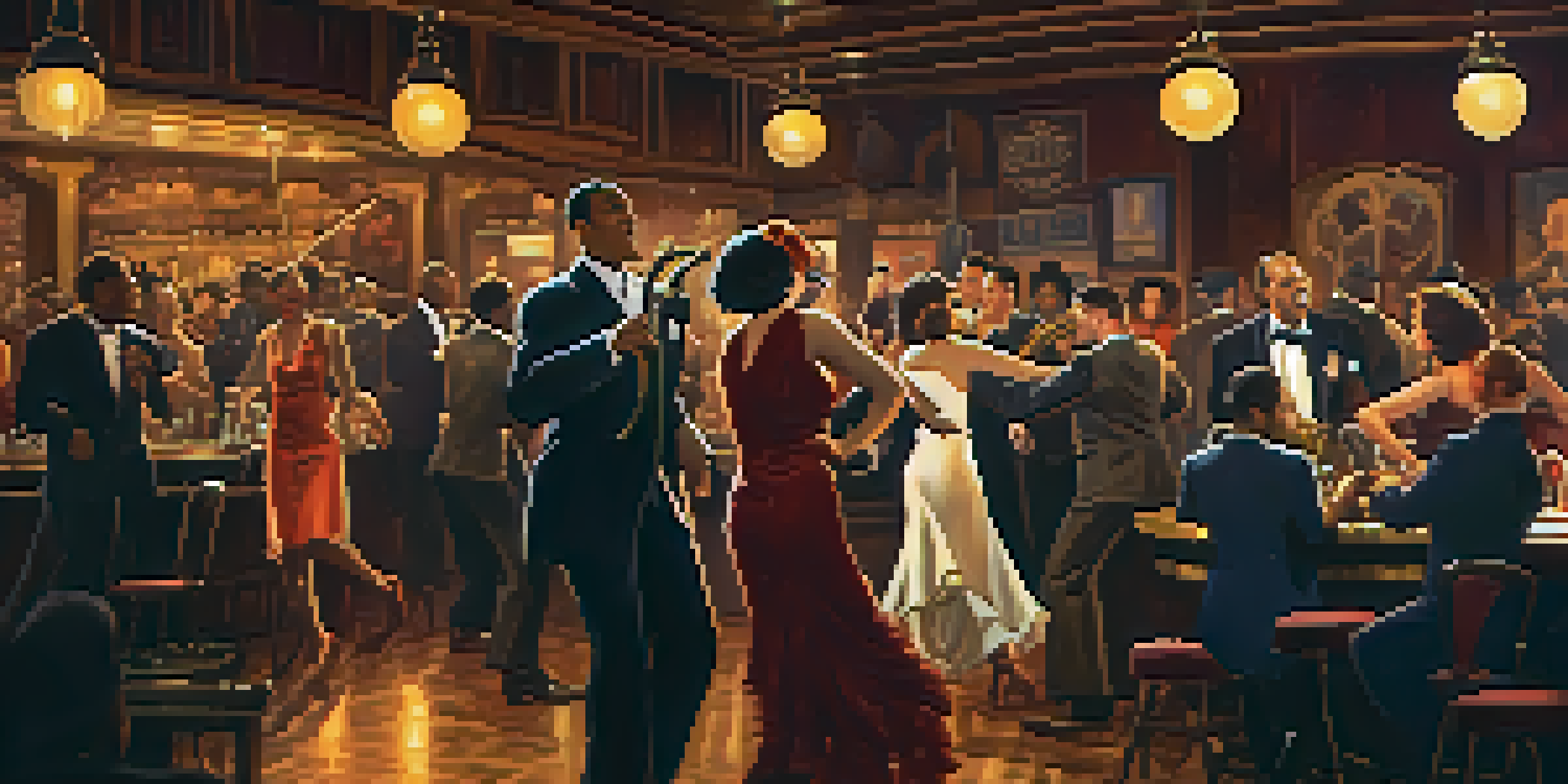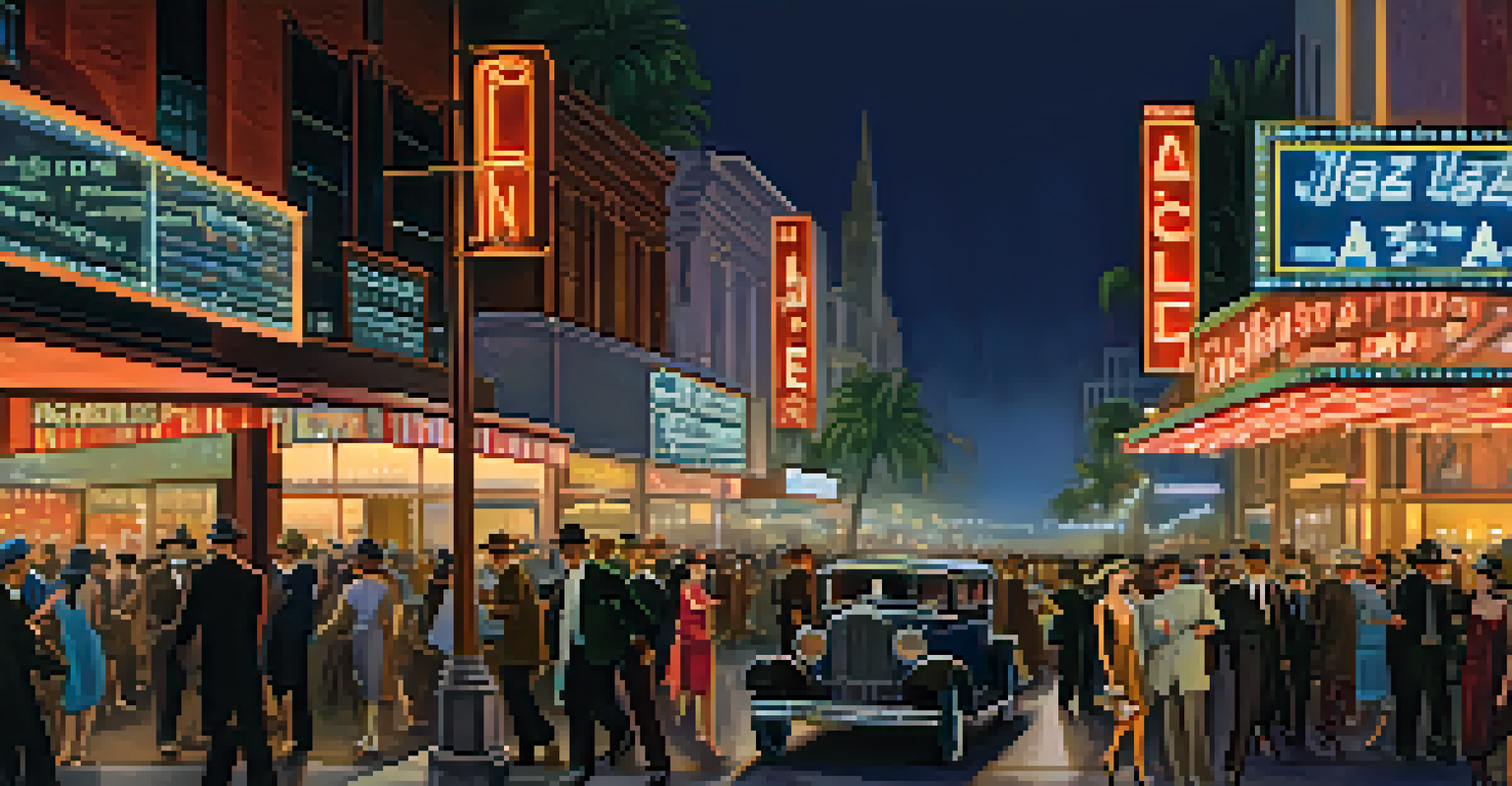The Rise of Jazz Clubs: LA's Nightlife in the 1920s Era

The Birth of Jazz: A Cultural Revolution
In the 1920s, jazz emerged as a revolutionary music genre, intertwining African American musical traditions with new influences. This vibrant sound quickly captivated audiences, becoming a symbol of the era's cultural shift. Jazz was not just music; it represented freedom, creativity, and a break from conventional norms. As the sounds of trumpets and saxophones filled the air, people from all walks of life began to gather, ready to experience something new and exciting.
Jazz is the most American music we have.
The early jazz musicians, many of whom migrated from New Orleans, brought with them a rich tapestry of rhythms and styles. Their performances were often spontaneous, creating an electrifying atmosphere that kept audiences on their toes. Clubs sprang up in cities across America, but Los Angeles quickly became a hotspot. The city's burgeoning film industry attracted artists and audiences alike, eager to embrace the jazz craze.
Jazz clubs became the heartbeat of LA's nightlife, offering a space where people could escape their daily lives. These venues were more than just places to listen to music; they were social hubs where diverse communities converged, sharing stories, laughter, and dance. In many ways, jazz clubs were a reflection of the changing American landscape, breaking down racial barriers and fostering a sense of unity through the power of music.
Iconic Jazz Clubs of the 1920s
As jazz grew in popularity, several iconic clubs emerged in Los Angeles, each with its unique vibe and flair. The Cotton Club, for instance, became a legendary venue that showcased some of the best talent of the era, including Duke Ellington and Louis Armstrong. With its glamorous decor and lively performances, it attracted an eclectic mix of patrons, making it a must-visit spot for jazz enthusiasts.

Another prominent venue was the Club Alabam, known for its lively atmosphere and talented performers. This club embraced a more informal setting, welcoming everyone from jazz aficionados to curious newcomers. Its charm lay in the way it fostered a sense of community, making even first-time visitors feel like regulars. The music flowed as freely as the drinks, and the dance floor was never empty.
Jazz as a Cultural Movement
In the 1920s, jazz emerged as a vibrant genre symbolizing freedom and creativity, uniting diverse communities through music.
These clubs were instrumental in shaping the jazz scene in LA, offering musicians a platform to showcase their talents and experiment with new sounds. The walls of these venues echoed with the laughter and applause of audiences, creating unforgettable memories. For many, a night out at a jazz club wasn’t just entertainment; it was an experience that lingered long after the last note had been played.
The Influence of Hollywood on Jazz Culture
In the 1920s, Hollywood was on the rise, and its influence on the jazz scene was undeniable. The film industry's growth created a demand for live music, and jazz became the soundtrack to many silent films, helping to propel the genre into the mainstream. This crossover not only expanded jazz's reach but also introduced audiences to a new wave of talent, many of whom would become legends.
It’s taken me all my life to learn what not to play.
Stars like Bessie Smith and Billie Holiday began to make their mark, captivating audiences both on and off the screen. The glamour of Hollywood intertwined with the vibrant energy of jazz clubs, creating an intoxicating mix that drew in crowds. As film studios sought to capitalize on the jazz craze, they often hosted lavish parties featuring live performances, further cementing the genre's place in popular culture.
This symbiotic relationship between jazz and Hollywood not only elevated the profile of the musicians but also contributed to the overall allure of LA nightlife. The clubs became a breeding ground for creativity, where artists collaborated and pushed the boundaries of their craft. The magic of jazz was now intertwined with the glitz and glamour of the silver screen, making Los Angeles the epicenter of a cultural phenomenon.
The Evolution of Jazz Styles in LA
As the jazz scene flourished in Los Angeles, various styles began to emerge, each reflecting the city's diverse cultural landscape. From the lively rhythms of swing to the more laid-back sounds of cool jazz, musicians experimented and blended genres, creating a unique sound that was distinctly Californian. This evolution was a testament to the creativity and adaptability of jazz artists during this vibrant era.
The influence of Latin music also played a significant role in shaping LA's jazz scene, as musicians incorporated elements of salsa and bossa nova into their performances. This fusion created a rich and diverse musical palette, allowing artists to reach wider audiences and experiment with new sounds. As a result, jazz became a melting pot of influences, reflecting the multicultural essence of Los Angeles.
Hollywood's Role in Jazz Popularity
Hollywood's rise in the 1920s intertwined with jazz, propelling the genre into the mainstream and showcasing legendary talents.
Jazz clubs began to showcase these evolving styles, attracting fans who were eager to experience the latest trends. Musicians pushed the boundaries of their art, constantly innovating and redefining what jazz could be. This spirit of experimentation not only enriched the genre but also solidified Los Angeles as a crucial hub for jazz innovation.
The Social Impact of Jazz Clubs
Jazz clubs in the 1920s were more than just entertainment venues; they served as important social spaces that promoted cultural exchange and unity. In an era marked by segregation and racial tension, these clubs became sanctuaries where people from different backgrounds could come together, dance, and enjoy live music. The shared experience of jazz fostered a sense of community, breaking down barriers and encouraging understanding.
Many clubs featured integrated bands, showcasing the talents of musicians regardless of race. This was revolutionary for the time, as it allowed for collaboration and mutual respect among artists. The dynamic performances created an atmosphere of inclusivity, where everyone was welcome to enjoy the music, regardless of their background or social status.
The impact of jazz clubs extended beyond the dance floor; they became a catalyst for social change. As audiences embraced the music and culture of jazz, they began to challenge societal norms, paving the way for future generations to continue the fight for equality. The clubs played a vital role in shaping not only the music scene but also the broader cultural landscape of America.
The Legacy of 1920s Jazz Clubs Today
The legacy of the jazz clubs from the 1920s is still felt in Los Angeles today. Many of the original venues may have closed their doors, but their spirit lives on in the thriving jazz scene that exists across the city. Modern clubs and performance spaces continue to celebrate the rich history of jazz, showcasing both classic and contemporary artists, ensuring that the genre remains relevant.
Jazz festivals and events are held throughout the year, drawing in crowds eager to experience the magic of live music. These gatherings not only pay homage to the past but also serve as platforms for new talent to emerge. The community that once gathered in the dimly lit clubs of the 1920s has transformed into a vibrant network of musicians, fans, and cultural advocates.
Social Impact of Jazz Clubs
Jazz clubs served as crucial social spaces that broke down racial barriers and fostered a sense of community during a segregated era.
As we look back on the rise of jazz clubs in LA, it's clear that their influence extends far beyond music. They played a pivotal role in shaping the cultural identity of the city and continue to inspire generations of artists and audiences alike. The spirit of jazz, characterized by creativity, collaboration, and resilience, remains alive and well, echoing through the streets of Los Angeles.
Conclusion: The Enduring Allure of Jazz
The rise of jazz clubs in 1920s Los Angeles marked a significant chapter in the city's history, one that continues to resonate today. These venues were not only places of entertainment but cultural epicenters that fostered innovation, collaboration, and unity. The music that filled the air was a reflection of the times, capturing the spirit of a generation eager for change.
As we reminisce about this vibrant era, it's essential to recognize the lasting impact these clubs had on both jazz and society as a whole. They opened doors for artists and audiences alike, challenging societal norms and paving the way for future generations. The legacy of these clubs serves as a reminder of the power of music to bring people together and inspire change.

Jazz clubs may have evolved over the years, but the essence of what they represented remains intact. The rhythm of jazz continues to pulse through the heart of Los Angeles, reminding us that the allure of this genre transcends time, uniting us through its rich history and vibrant present.